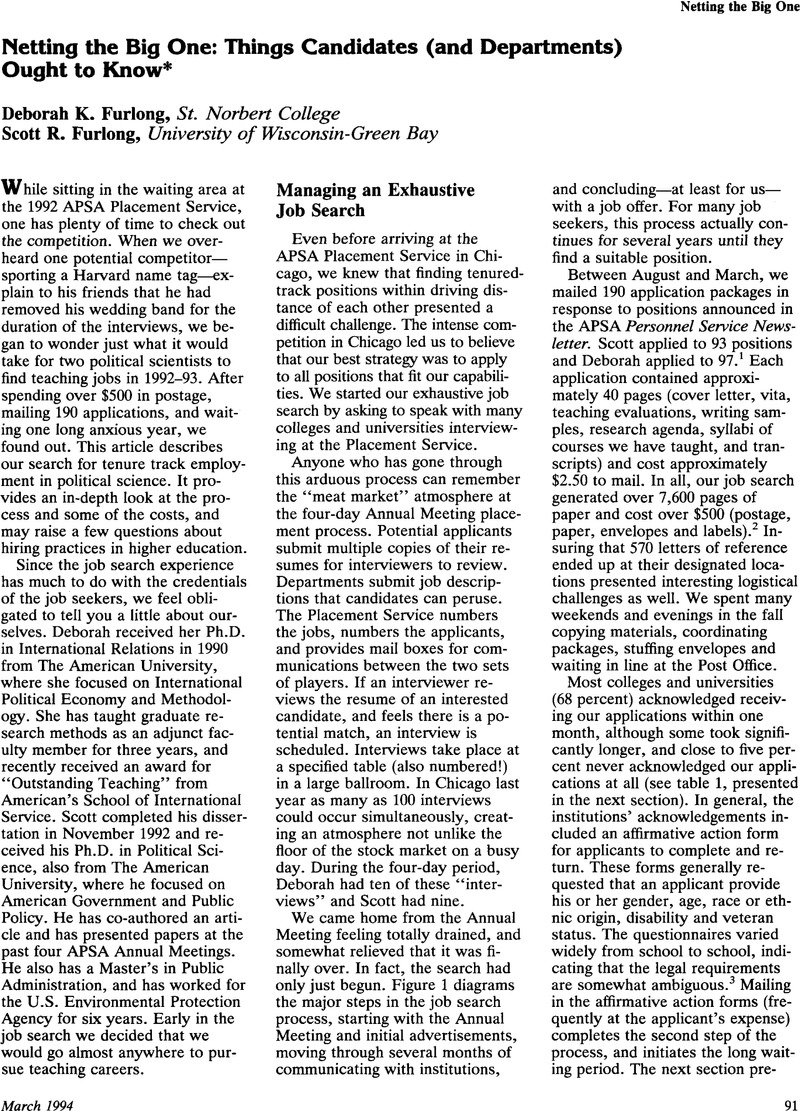Published online by Cambridge University Press: 02 September 2013

We wish to thank Samantha Durst, Cornelius Kerwin, Mike Kraft, Laura Langbein, and Kevin Snider for their very helpful comments and suggestions on this article.
1. We realize that at this point more than one department chair and search committee member will throw this article down in disgust, cursing our names for increasing their work loads during this past year. In our defense, let us make three points. First of all, we can both teach across several traditional areas (International Relations, Comparative Politics, Methodology, American Politics, Public Policy, Public Administration), which increases the number of positions we felt capable of filling. Second, we did execute certain exclusions. We did not apply to certain geographic locations (e.g., New York City area, Hawaii, Alaska and Canada). In addition, we did not apply to many of the “Ivy League” institutions. Third, wanting to find two positions within 150 miles of each other encouraged us to apply to schools that we would have otherwise avoided. Finally, our marital status made the prospects of spending more than one year on the job market particularly unrealistic. Whereas our single friends can accept a series of one year appointments and move around for a few years before landing a tenure-track appointment, professional partners can not re-create their careers in new locations on an annual basis.
2. We purchased paper that we used in copy machines at our jobs. Our expenses would have more than doubled if we had to pay copying costs as well. We recently learned that our departments might have paid for copying and postage. Candidates should explore this possibility with their own departments.
3. Several forms either asked for our names or already contained our names on them, and then asked for items like age, gender and ethnic origin. Most forms clearly indicated that providing the information was voluntary. Still, we did not understand the need to ask for applicants' names on the forms.
4. Dates are determined as follows: application dates are based on the date application was mailed; initial response dates and final correspondence dates use the date listed on the letter.
5. Judging by some of the odd rejection letters we received, writing them is not particularly easy either.
6. Several of our reviewers questioned calling a rejection letter a nibble. However, people frequently learn of a nibble when they pull up the line and find a half-eaten worm.
7. A few weeks after Deborah mailed her application for the school's tenure-track opening, the chairman called. He said that the search committee had not yet begun to deliberate, but asked if she would consider teaching a course in the spring, as an adjunct. Due to prior commitments (namely working full time and teaching a course at American), Deborah had to refuse the offer. We assumed that when the committee made their initial cuts, Deborah would at least receive an invitation to interview for the position.
8. However, we would like to thank all the schools that bothered to count up the applications and enabled us to write this section!
9. Scott taught his first class in Spring 1993, and received his first evaluations after signing the contract with the University of Wisconsin-Green Bay.